
| Самолеты (сортировка по:) | |||||
| Страна | Конструктор | Название | Год | Фото | Текст |
LVG B.I

|
Страна: Германия Год: 1914
Unarmed two-seat scout, reconnaissance and training aircraft |
| LVG - monoplane - 1913 - Германия | <– | –> | LVG - B.II - 1914 - Германия |
 |
J.Herris - LVG Aircraft of WWI. Volume 1: B-Types & C.I /Centennial Perspective/ (34) |
| LVG B.I with tricycle nose gear in early war service with the Bavarian Flying Corps. Note early style of Eisernes Kreuz on rudder. |
 |
J.Herris - LVG Aircraft of WWI. Volume 1: B-Types & C.I /Centennial Perspective/ (34) |
| LVG B.I flown by the Bavarians. Note the interesting rudder cross. |
 |
J.Herris - LVG Aircraft of WWI. Volume 1: B-Types & C.I /Centennial Perspective/ (34) |
| LVG B.I no. 2 from the LVG factory school at Johannisthal with early brow radiator. |
 |
J.Herris - LVG Aircraft of WWI. Volume 1: B-Types & C.I /Centennial Perspective/ (34) |
| LVG B.I of the Herzog Karl Friedrich Fliegerschule at Gotha Number 14. The black & white circle was the unit marking. |
 |
J.Herris - LVG Aircraft of WWI. Volume 1: B-Types & C.I /Centennial Perspective/ (34) |
| LVG B.I trainer as indicated by the wood wheels. School number 32. |
 |
J.Herris - LVG Aircraft of WWI. Volume 1: B-Types & C.I /Centennial Perspective/ (34) |
| LVG B.I B.1123/15 is an armed B.I with turret installed in the rear cockpit. It looks like it was converted to an early C.I and confusingly has a second serial number, 108/15. |
 |
J.Herris - LVG Aircraft of WWI. Volume 1: B-Types & C.I /Centennial Perspective/ (34) |
| LVG B.I 211/15. |
 |
J.Herris - Otto, AGO and BFW Aircraft of WWI /Centennial Perspective/ (37) |
| LVG B.I(Ot) 636/16. |
 |
J.Herris - Development of German Warplanes in WWI /Centennial Perspective/ (1) |
| LVG B.I(Ot) 636/16. The serial number suffix '16' and white outline around the national insignia are characteristic of use as a trainer; by 1916 B-types were purchased for training, not front-line use. Aircraft used for training in Germany were not counted in the Frontbestand. |
 |
J.Herris - LVG Aircraft of WWI. Volume 1: B-Types & C.I /Centennial Perspective/ (34) |
| LVG B.I(Otto) serving with FFA 8b (Bavarian) The white fuselage band is an early marking for the unit. |
 |
J.Herris - Otto, AGO and BFW Aircraft of WWI /Centennial Perspective/ (37) |
| LVG B.I(Ot) of Feld-Flieger Abteilung 8b, Colmer Aerodrome, August 1915. |
 |
J.Herris - Otto, AGO and BFW Aircraft of WWI /Centennial Perspective/ (37) |
| LVG B.I(Ot) Bauernmichel! from Feld-Flieger-Abteilung 7b. |
 |
J.Herris - LVG Aircraft of WWI. Volume 1: B-Types & C.I /Centennial Perspective/ (34) |
| LVG B.I 00.16 trainer of the Austro-Hungarian Luftfahrtruppe, Summer 1916. |
 |
J.Herris - LVG Aircraft of WWI. Volume 1: B-Types & C.I /Centennial Perspective/ (34) |
| LVG B.I built for Turkey |
 |
J.Herris - LVG Aircraft of WWI. Volume 1: B-Types & C.I /Centennial Perspective/ (34) |
| Photo of an LVG B.I trainer with skid under-carriage issued as a postcard. (Peter M. Grosz Collection/STDB) |
 |
J.Herris - LVG Aircraft of WWI. Volume 1: B-Types & C.I /Centennial Perspective/ (34) |
| Early LVG B.I with skid under-carriage. |
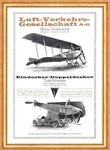 |
J.Herris - LVG Aircraft of WWI. Volume 3: Types C.VI-C.XI & Fighters /Centennial Perspective/ (36) |
 |
Jane's All The World Aircraft 1919 /Jane's/ |
| L.V.G. B.I reconnaissance biplane of 1914-15, unarmed and using either a 110 h.p. Benz or a 100 h.p. Mercedes engine. |
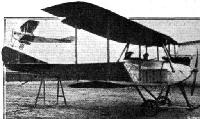 |
Журнал - Flight за 1914 г. |
| 26. The new type L.V.G. biplane. |
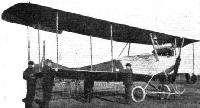 |
Журнал - Flight за 1914 г. |
| The L.V.G. biplane. |
 |
J.Herris - LVG Aircraft of WWI. Volume 1: B-Types & C.I /Centennial Perspective/ (34) |
| LVG B.I with skid under-carriage in the field with a cavalry man, the army's original reconnaissance asset. (Peter M. Grosz Collection/STDB) |
 |
J.Herris - LVG Aircraft of WWI. Volume 1: B-Types & C.I /Centennial Perspective/ (34) |
| Pre-war LVG B.I trainer with skid under-carriage and 120 hp Argus As.II engine; the exhaust pipe goes down, through the engine cowling and exhausts below the fuselage. (Peter M. Grosz Collection/STDB) |
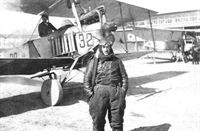 |
J.Herris - LVG Aircraft of WWI. Volume 1: B-Types & C.I /Centennial Perspective/ (34) |
| LVG B.I trainer with wood wheels and mud guards. (Greg VanWyngarden) |
 |
J.Herris - LVG Aircraft of WWI. Volume 1: B-Types & C.I /Centennial Perspective/ (34) |
| This early-production LVG B.I with skid under-carriage has no national insignia but wears competition # "11" on the rear fuselage, indicating the photo was taken at a flying competition before the war. |
 |
J.Herris - LVG Aircraft of WWI. Volume 1: B-Types & C.I /Centennial Perspective/ (34) |
| Clear photo of an LVG B.I trainer with skid under-carriage. (Peter M. Grosz Collection/STDB) |
 |
J.Herris - LVG Aircraft of WWI. Volume 1: B-Types & C.I /Centennial Perspective/ (34) |
| Max Immelmann sits alone in the pilot's aft cockpit of a running LVG B.I during his flight training days at Johannisthal. |
 |
J.Herris - LVG Aircraft of WWI. Volume 1: B-Types & C.I /Centennial Perspective/ (34) |
| LVG B.I B.18/13 with crew in front of the LVG flying school at Johannisthal. (Peter M. Grosz Collection/STDB) |
 |
J.Herris - LVG Aircraft of WWI. Volume 1: B-Types & C.I /Centennial Perspective/ (34) |
| LVG B.I 93/13 was a pre-war trainer without national insignia. (Greg VanWyngarden) |
 |
J.Herris - LVG Aircraft of WWI. Volume 1: B-Types & C.I /Centennial Perspective/ (34) |
| Early-production LVG B.I B.102/13 with skid under-carriage has no national insignia, indicating training use. (Peter M. Grosz Collection/STDB) |
 |
Журнал - Flight за 1914 г. |
| THE PRINCE HENRY CIRCUIT. - On the left, v. Thuna, the winner of the Kaiserprize, with Lieut, v. Kleist, his observer, and their 100 h.p. Mercedes biplane. On the right (from right to left), Prince Henry of Prussia, Messrs. Trutz, Geheimer Rat Buxenstein, Winter (K.F.A.C.). (From the Allgemeine Automobil Zeitung.) |
 |
Журнал - Flight за 1914 г. |
| On the left, an observer in an aeroplane is shown in the act of transmitting a message to the ground, and on the right an observer is seen reading a message, while a signaller is standing by ready to reply thereto. |
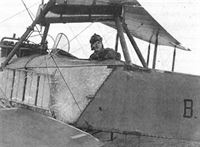 |
J.Herris - LVG Aircraft of WWI. Volume 1: B-Types & C.I /Centennial Perspective/ (34) |
| LVG B-type. The turned aluminum nose panels with fabric covered wings and rear fuselage were typical for early LVG designs. (Reinhard Zankl) |
 |
J.Herris - LVG Aircraft of WWI. Volume 1: B-Types & C.I /Centennial Perspective/ (34) |
| Observer posing in a LVG B. The small gravity fuel tank under the upper wing and engine-turned metal panels are clearly shown. (Reinhard Zankl) |
 |
J.Herris - LVG Aircraft of WWI. Volume 1: B-Types & C.I /Centennial Perspective/ (34) |
| LVG B.I No.14 trainer at the Herzog Eduard Fliegerschule at Gotha. The Mercedes engine has no exhaust header and each cylinder has its own exhaust pipe. The flight school aircraft were privately owned so did not have military serial numbers; Fliegertruppe men were give pilot training under contract. (Peter M. Grosz Collection/STDB) |
 |
J.Herris - LVG Aircraft of WWI. Volume 1: B-Types & C.I /Centennial Perspective/ (34) |
| Fahnrich Max Immelmann (left) and his observer, Lt. Ehrhardt von Teubern, pose in front of their LVG B.I 318/15 after having been attacked by an armed, French Farman biplane. Immelmann described the attack as: "When we landed, they counted our bullet-holes. There are about five or six harmless ones in the wings. A solitary one grazed our main spar, without breaking it. One shot went clean through the engine's bed. The metal cowling which encloses the lower part of the engine looks like a sieve." |
 |
J.Herris - LVG Aircraft of WWI. Volume 1: B-Types & C.I /Centennial Perspective/ (34) |
| Propaganda photo showing LVG B-type with small gravity tank and insignia painted inboard on the wings. The notation indicates the flying officers are briefing at their field site before flight. (Reinhard Zankl) |
 |
J.Herris - LVG Aircraft of WWI. Volume 1: B-Types & C.I /Centennial Perspective/ (34) |
| LVG B.I B.215/15 appears to be at a home training unit. Some guards demonstrate a bomb. |
 |
J.Herris - LVG Aircraft of WWI. Volume 1: B-Types & C.I /Centennial Perspective/ (34) |
| Early-production LVG B B.108 (/13?) wears its national insignia well inboard on the top and bottom of both wings. |
 |
J.Herris - LVG Aircraft of WWI. Volume 1: B-Types & C.I /Centennial Perspective/ (34) |
| Another view of the air and ground crew posing with LVG B.I B.269/15. Note the small gravity tank (Greg VanWyngarden) |
 |
J.Herris - LVG Aircraft of WWI. Volume 1: B-Types & C.I /Centennial Perspective/ (34) |
| Air and ground crew pose with LVG B.I B.269/15. (Greg VanWyngarden) |
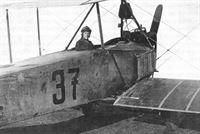 |
J.Herris - LVG Aircraft of WWI. Volume 1: B-Types & C.I /Centennial Perspective/ (34) |
| Well-used LVG B.I trainer no. 37. (Reinhard Zankl) |
 |
J.Herris - LVG Aircraft of WWI. Volume 1: B-Types & C.I /Centennial Perspective/ (34) |
| LVG B.I with skid under-carriage, pilot Lt. Freiherr von Thuna, and observer Lt. Fritz von Falkenhayn, son of the German War Minister. Engine is a 100 hp Mercedes D.I. (Peter M. Grosz Collection/STDB) |
 |
J.Herris - LVG Aircraft of WWI. Volume 1: B-Types & C.I /Centennial Perspective/ (34) |
| Hptm. Heimbach in LVG B.l B425/14 with engine running before take-off. |
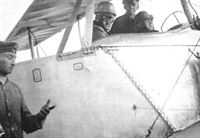 |
J.Herris - LVG Aircraft of WWI. Volume 1: B-Types & C.I /Centennial Perspective/ (34) |
| LVG B.I with two bullet holes patched and dated. (Greg VanWyngarden) |
 |
J.Herris - LVG Aircraft of WWI. Volume 1: B-Types & C.I /Centennial Perspective/ (34) |
| Another photo of LVG B.I 223/14. |
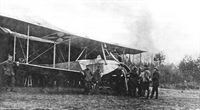 |
J.Herris - LVG Aircraft of WWI. Volume 1: B-Types & C.I /Centennial Perspective/ (34) |
| LVG B.I probably on the Eastern Front. (Greg VanWyngarden) |
 |
J.Herris - LVG Aircraft of WWI. Volume 1: B-Types & C.I /Centennial Perspective/ (34) |
| LVG B.I with FFA 6 ready for its next flight with ground crewmen. (Peter M. Grosz Collection/STDB) |
 |
J.Herris - LVG Aircraft of WWI. Volume 1: B-Types & C.I /Centennial Perspective/ (34) |
| LVG B.I with apparatus under the fuselage for dropping bombs with two bombs. (Peter M. Grosz Collection/STDB) |
 |
J.Herris - LVG Aircraft of WWI. Volume 1: B-Types & C.I /Centennial Perspective/ (34) |
| LVG B.I and crew with a mechanic in the cockpit. (Greg VanWyngarden) LVG B-type with small gravity tank. Note insignia painted outboard on both sides of all wings. (Reinhard Zankl) |
 |
J.Herris - LVG Aircraft of WWI. Volume 1: B-Types & C.I /Centennial Perspective/ (34) |
| LVG B.I with bomb-dropping chutes behind the landing gear to prevent bombs catching onto the aircraft after the observer has dropped them. (Greg VanWyngarden) |
 |
J.Herris - LVG Aircraft of WWI. Volume 1: B-Types & C.I /Centennial Perspective/ (34) |
| LVG B.I in the snow with Krahnen, Koops, Hauptmann von Kaltenborn, and mechanics. |
 |
J.Herris - LVG Aircraft of WWI. Volume 1: B-Types & C.I /Centennial Perspective/ (34) |
| Lt. Kessing with an LVG B-type. (Bruno Schmaling) |
 |
J.Herris - LVG Aircraft of WWI. Volume 1: B-Types & C.I /Centennial Perspective/ (34) |
| An LVG B.I from FeldfliegerAbteilung 16 is decorated with an Iron Cross. German warplanes that had participated in conspicuous actions were sometimes decorated with an honorary Iron Cross award as shown here. |
 |
J.Herris - LVG Aircraft of WWI. Volume 1: B-Types & C.I /Centennial Perspective/ (34) |
| LVG B-type trainer in its hangar. (Reinhard Zankl) |
 |
J.Herris - LVG Aircraft of WWI. Volume 1: B-Types & C.I /Centennial Perspective/ (34) |
| LVG B-type in the field. Note early insignia painted inboard on both sides of all wings. (Reinhard Zankl) |
 |
J.Herris - LVG Aircraft of WWI. Volume 1: B-Types & C.I /Centennial Perspective/ (34) |
| LVG B.I trainer at FEA 8 with trainee Arthur Rahn. Arthur Rahn later served in Fl. Abt. 7 and then became a well-known six-victory ace flying in Jastas 19, 18, 15, and 19 again. The Fokker Dr.I in the NMUSAF is painted in his Jasta 19 markings. |
 |
J.Herris - LVG Aircraft of WWI. Volume 1: B-Types & C.I /Centennial Perspective/ (34) |
| LVG B-type in the field with ground crew. (Reinhard Zankl) |
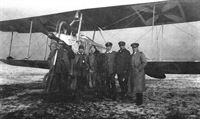 |
J.Herris - LVG Aircraft of WWI. Volume 1: B-Types & C.I /Centennial Perspective/ (34) |
| Flyers pose with LVG B.I trainer. (Greg VanWyngarden) |
 |
J.Herris - LVG Aircraft of WWI. Volume 1: B-Types & C.I /Centennial Perspective/ (34) |
| Early LVG B-type with small gravity tank. The photo shows flying officers with the iron cross 1st or 2nd class. (Reinhard Zankl) |
 |
J.Herris - LVG Aircraft of WWI. Volume 1: B-Types & C.I /Centennial Perspective/ (34) |
| Flight and ground crew with LVG B-type of FFA 8b. (Bruno Schmaling) |
 |
J.Herris - LVG Aircraft of WWI. Volume 1: B-Types & C.I /Centennial Perspective/ (34) |
| LVG B.I and staff of Flieger-Abteilung 21. |
 |
J.Herris - LVG Aircraft of WWI. Volume 1: B-Types & C.I /Centennial Perspective/ (34) |
| LVG B.I 421 at the front. |
 |
J.Herris - LVG Aircraft of WWI. Volume 1: B-Types & C.I /Centennial Perspective/ (34) |
| LVG B.I with the 'Y' brindle cable bracing ordered by the Fliegertruppe to prevent wing deformation at 'high' speed. (Peter M. Grosz Collection/ STDB) |
 |
J.Herris - LVG Aircraft of WWI. Volume 1: B-Types & C.I /Centennial Perspective/ (34) |
| LVG B-type with small gravity tank. Note insignia painted outboard on both sides of all wings. (Reinhard Zankl) |
 |
J.Herris - LVG Aircraft of WWI. Volume 1: B-Types & C.I /Centennial Perspective/ (34) |
| LVG B.I of FFA 4 and crew in the snow on the Eastern Front in early 1915. The pilot in the dark coat is Franz Ray. Franz Ray later became a 17-victory ace, serving in Jasta 1, then Jasta 28w, and finally Jasta 49 (and was a subject of a Sanke Card). The observer in the LVG holds a Fliegerkammer 1911 L30 Zeiss. |
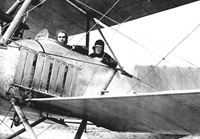 |
J.Herris - LVG Aircraft of WWI. Volume 1: B-Types & C.I /Centennial Perspective/ (34) |
| LVG B.I with air and ground crew. (Greg VanWyngarden) |
 |
J.Herris - LVG Aircraft of WWI. Volume 1: B-Types & C.I /Centennial Perspective/ (34) |
| LVG B.I B.223/154 after internment, the radiator differs from the side radiators fitted at internment. |
 |
J.Herris - LVG Aircraft of WWI. Volume 1: B-Types & C.I /Centennial Perspective/ (34) |
| LVG B.I trainer with aviators from the Austro-Hungarian Luftfahrtruppen and German Fliegertruppe & national insignia on wheel cover. (Peter M. Grosz Collection/STDB) |
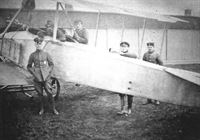 |
J.Herris - LVG Aircraft of WWI. Volume 1: B-Types & C.I /Centennial Perspective/ (34) |
| LVG B.I with crew (Greg VanWyngarden) |
 |
J.Herris - LVG Aircraft of WWI. Volume 1: B-Types & C.I /Centennial Perspective/ (34) |
| LVG B.I assigned to FFA 28 is loaded with some 10 kg Goldschmidt incendiary bombs. The aircraft has a bombing chute attached to the side. The LVG could carry 4-5 of these primitive bombs. (Peter M. Grosz Collection/STDB) |
 |
A.Imrie - German Bombers /Arms & Armour/ |
| Four early 10kg Carbonit bombs suspended from release hooks under the fuselage of an LVG B I. The safety pins to prevent windvane rotation had to be tied with wire or string to the release hooks, the operation of which withdrew the pins and allowed arming of the fuse. Later a disc was spring-loaded against the windvanes to prevent rotation. After release, air pressure forced the disc clear of the windvanes and the bomb was then armed in the usual way. The four-bladed windmill operated air pump for pressurizing the fuel system can be seen on the port front undercarriage leg. |
 |
J.Herris - LVG Aircraft of WWI. Volume 1: B-Types & C.I /Centennial Perspective/ (34) |
| LVG B.I thought to be assigned to FFA 5b shows its method of carrying bombs. The small 4-bladed propeller on the left front landing gear strut powers the fuel pump. |
 |
J.Herris - LVG Aircraft of WWI. Volume 1: B-Types & C.I /Centennial Perspective/ (34) |
| LVG B.I with aileron control cables led through the wing; previous models had external cables. The 4-bladed propeller powered the fuel pump. A metal strip on the lower wing is a walkway. (Peter M. Grosz Collection/STDB) |
 |
A.Imrie - German Bombers /Arms & Armour/ |
| This LVG B I of Feldflieger Abteilung 16 on the Eastern Front, depicted during winter of 1914/15, has been fitted with an oblique wire cage chute so that bombs, carried in the front (observer's) cockpit, will not foul the bottom wing during release. Usually two 4.5kg Carbonit bombs comprised the bombload. The safety wire and pin that prevented inadvertent rotation of the windvane-armed fuse had to be completely removed before placing the bomb in the chute. The issue bomb chutes were of varied design to suit different aircraft types but improvised examples were also made in the field by unit personnel. |
 |
J.Herris - LVG Aircraft of WWI. Volume 1: B-Types & C.I /Centennial Perspective/ (34) |
| LVG B.I fitted with a bomb-launching chute photographed in winter 1914; the photo was reproduced as a postcard. The 'a' after the serial indicates a repaired aircraft or replacement for the original. (Peter M. Grosz Collection/STDB) |
 |
J.Herris - LVG Aircraft of WWI. Volume 1: B-Types & C.I /Centennial Perspective/ (34) |
| LVG B.I B.275/13 being readied for take-off. It has an early, non-standard presentation of its national insignia on the wings. (Peter M. Grosz Collection/STDB) |
 |
J.Herris - LVG Aircraft of WWI. Volume 1: B-Types & C.I /Centennial Perspective/ (34) |
| LVG B.I B.223/14 with skid under-carriage and engine running ready for take-off. It has national insignia on the top and bottom of all wings at an extreme outboard position and ID streamers to preclude 'friendly' fire; the photo was taken early in the war. (Peter M. Grosz Collection/STDB) |
 |
J.Herris - LVG Aircraft of WWI. Volume 1: B-Types & C.I /Centennial Perspective/ (34) |
| LVG B.I 223/14 was later interned in Holland and flown as LA 25 in the Dutch air service. |
 |
J.Herris - LVG Aircraft of WWI. Volume 1: B-Types & C.I /Centennial Perspective/ (34) |
| LVG B.I B228/14 during take-off. The LVG cranked ailerons are distinctive. (Peter M. Grosz Collection/STDB) |
 |
J.Herris - LVG Aircraft of WWI. Volume 1: B-Types & C.I /Centennial Perspective/ (34) |
| Mechanic prepares to start LVG B.I B.425/14 on a snowy field. |
 |
J.Herris - LVG Aircraft of WWI. Volume 1: B-Types & C.I /Centennial Perspective/ (34) |
| Hptm. Heimbach in LVG B.I B425/14 with engine running before take-off. |
 |
J.Herris - LVG Aircraft of WWI. Volume 1: B-Types & C.I /Centennial Perspective/ (34) |
| LVG B.I B.211/15 and a comrade are ready for their next mission. A barograph has been fitted, likely for monitoring training flights. (Peter M. Grosz Collection/STDB) |
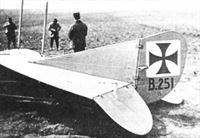 |
J.Herris - LVG Aircraft of WWI. Volume 1: B-Types & C.I /Centennial Perspective/ (34) |
| LVG B.I B.251/15 (work no. 361) after capture by the French. |
 |
J.Herris - LVG Aircraft of WWI. Volume 1: B-Types & C.I /Centennial Perspective/ (34) |
| LVG B.I in a field hangar at FFA 62, the unit Boelcke and Immelmann were originally assigned to; boards have been provided to make it easier to move the aircraft. The aircraft is Max Immelmann's B.I 318/15. It was damaged in an attack by a French Farman biplane. (Bruno Schmaling) |
 |
J.Herris - LVG Aircraft of WWI. Volume 1: B-Types & C.I /Centennial Perspective/ (34) |
| LVG B.I B.55/14 in flight. |
 |
J.Herris - LVG Aircraft of WWI. Volume 1: B-Types & C.I /Centennial Perspective/ (34) |
| LVG B-type trainers making a formation flight at a flight school. |
 |
J.Herris - LVG Aircraft of WWI. Volume 1: B-Types & C.I /Centennial Perspective/ (34) |
| This early-production LVG B.I was flown by the Bavarians during the early months of the war. The under-carriage skid was intended to help avoid nose-overs while landing on the rough airfields of the time and was a feature of early-production aircraft. Later production LVG B.I aircraft omitted the landing gear skid. The early style national insignia on the rudder is interesting. Power was from a 100 hp Mercedes D.I engine. (Peter M. Grosz Collection/STDB) |
 |
J.Herris - LVG Aircraft of WWI. Volume 1: B-Types & C.I /Centennial Perspective/ (34) |
| LVG B.I with engine running ready for take-off. (Greg VanWyngarden) |
 |
J.Herris - LVG Aircraft of WWI. Volume 1: B-Types & C.I /Centennial Perspective/ (34) |
| Two LVG B.I aircraft of Bavarian FFA 5 parked by their tents at La Pouilerie Ferme in the war's early months. (Peter M. Grosz Collection/STDB) |
 |
J.Herris - LVG Aircraft of WWI. Volume 1: B-Types & C.I /Centennial Perspective/ (34) |
| LVG B.I trainers numbers 2, 9, and 10 of the LVG factory flying school in Johannisthal. The school trained army pilots under contract and owned the airplanes, so they did not carry military serial numbers. The Parseval airship shed was destroyed on 10 October 1915 and the photo was taken after that. (Peter M. Grosz Collection/STDB) |
 |
J.Herris - LVG Aircraft of WWI. Volume 1: B-Types & C.I /Centennial Perspective/ (34) |
| LVG B-type in the field. Note early insignia painted inboard on both sides of all wings. The different insignia position on the upper wings indicates one has been replaced. |
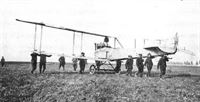 |
J.Herris - LVG Aircraft of WWI. Volume 1: B-Types & C.I /Centennial Perspective/ (34) |
| The ground crew maneuvers an LVG B.I across an airfield. |
 |
J.Herris - LVG Aircraft of WWI. Volume 1: B-Types & C.I /Centennial Perspective/ (34) |
| LVG B.I 935 being retrieved by a truck. (Greg VanWyngarden) |
 |
J.Herris - LVG Aircraft of WWI. Volume 1: B-Types & C.I /Centennial Perspective/ (34) |
| Habicht is seen in front of one of FFA 24's hangars. As on the other converted A.IIIs, the wings were mounted in the upper position on E 6/15. (Peter M. Grosz collection/STDB) LVG B.I in the field with Fokker Eindecker E.I 6/15 of Uffz. Dietrich of FFA 24 in 1915 - so the LVG was probably from FFA 24 too. The Fokker displayed the name Habicht (Hawk) and an insignia of a hawk, one of the very first personal markings on a German fighter. (Peter M. Grosz Collection/STDB) |
 |
J.Herris - LVG Aircraft of WWI. Volume 1: B-Types & C.I /Centennial Perspective/ (34) |
| Lineup of LVG B.I trainers under inspection on 5 January 1915. |
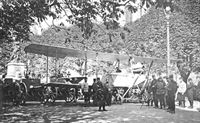 |
J.Herris - LVG Aircraft of WWI. Volume 1: B-Types & C.I /Centennial Perspective/ (34) |
| Captured LVG B.I on display in France. |
 |
J.Herris - LVG Aircraft of WWI. Volume 1: B-Types & C.I /Centennial Perspective/ (34) |
| LVG B.I on a permanent field in Germany. (Peter M. Grosz Collection/STDB) |
 |
J.Herris - LVG Aircraft of WWI. Volume 1: B-Types & C.I /Centennial Perspective/ (34) |
| Early LVG B.I with skid under-carriage. Note the extreme outboard position of the insignia under the upper wing. (Peter M. Grosz Collection/STDB) |
 |
J.Herris - LVG Aircraft of WWI. Volume 1: B-Types & C.I /Centennial Perspective/ (34) |
| The LVG Doppeldecker System Schneider trainer shown here was designed by Franz Schneider. It met the Army's requirements for a two-seat reconnaissance aircraft and was very successful. The orders for this aircraft established LVG as one of the most important German aircraft manufactures. This aircraft, retroactively designated the LVG B.I, became the foundation of LVG success and the ancestor of LVG designs up to and including the LVG C.IV. The LVG B.I was the most numerous of the aircraft types with which the Fliegertruppe started the war. This one was powered by a 110 hp Benz Bz.II. |
 |
J.Herris - LVG Aircraft of WWI. Volume 1: B-Types & C.I /Centennial Perspective/ (34) |
| Otto-built LVG B.I(Ot) photographed with its pilot. The aircraft bears the black and white fuselage band markings of aircraft in units of ‘‘Armee-Abteilung Gaede". (Peter M. Grosz Collection/STDB) |
 |
J.Herris - Otto, AGO and BFW Aircraft of WWI /Centennial Perspective/ (37) |
| Photographed 11 July 1917, this Otto-built LVG B.I(Ot) was 87/15. All metal parts are painted, probably in Feldgrau (field gray) color. (Peter M. Grosz Collection/STDB) |
 |
J.Herris - Otto, AGO and BFW Aircraft of WWI /Centennial Perspective/ (37) |
| LVG B.I(Ot) 636/16 was part of an Otto-built batch of 20 ordered in November 1916. The vertical line on the fuselage marks the boundary of wood and fabric and was seen only on B.6xx/16 series LVG B.I aircraft built or repaired by Otto. Power is by a 100 hp Mercedes D.I. (Peter M. Grosz Collection/STDB) |
 |
J.Herris - LVG Aircraft of WWI. Volume 1: B-Types & C.I /Centennial Perspective/ (34) |
| LVG B.I trainers at the LVG flying school at Koslin. (Peter M. Grosz Collection/STDB) |
 |
J.Herris - Otto, AGO and BFW Aircraft of WWI /Centennial Perspective/ (37) |
| LVG B.I(Ot) number 184 with pilot Gustav Bauer in 1916. Bauer later became a pilot for the Pfalz company and tested the Pfalz D.X parasol monoplane fighter prototype. (Gustav Bauer collection) |
 |
J.Herris - LVG Aircraft of WWI. Volume 1: B-Types & C.I /Centennial Perspective/ (34) |
| LVG B-type of FFA 8b. (Bruno Schmaling) |
 |
J.Herris - LVG Aircraft of WWI. Volume 1: B-Types & C.I /Centennial Perspective/ (34) |
| Flight crew with LVG B-type of FFA 8b. (Bruno Schmaling) |
 |
J.Herris - LVG Aircraft of WWI. Volume 1: B-Types & C.I /Centennial Perspective/ (34) |
| Otto-built LVG B.I(Ot) Bauernmichel. (Reinhard Kastner) |
 |
J.Herris - LVG Aircraft of WWI. Volume 1: B-Types & C.I /Centennial Perspective/ (34) |
| The crew of this LVG B-type assigned to FFA 6b poses proudly with their aircraft. Note the early national insignia painted inboard on the top of the lower wing. (Bruno Schmaling) |
 |
J.Herris - LVG Aircraft of WWI. Volume 1: B-Types & C.I /Centennial Perspective/ (34) |
| Otto-built LVG B.I(Ot); the pilot waits while residual fuel is drained. (Peter M. Grosz Collection/STDB) |
 |
J.Herris - LVG Aircraft of WWI. Volume 1: B-Types & C.I /Centennial Perspective/ (34) |
| LVG B.I '50' with Lt. Oskar Seitz who flew in FA(A) 292b and FA(A) 188b as well as Jasta 30. The aircraft was incorrectly marked 50/15; that serial belonged to an Albatros B.II. The front strut inside the longeron indicates it is Otto-built. |
 |
J.Herris - Otto, AGO and BFW Aircraft of WWI /Centennial Perspective/ (37) |
| Gustav Bauer with an LVG B.I(Ot). (Gustav Bauer collection) |
 |
J.Herris - LVG Aircraft of WWI. Volume 1: B-Types & C.I /Centennial Perspective/ (34) |
| LVG B.I in flight with a banner attached to the rudder. (Peter M. Grosz Collection/STDB) |
 |
J.Herris - LVG Aircraft of WWI. Volume 1: B-Types & C.I /Centennial Perspective/ (34) |
| LVG B.I(Ot) fitted with a Rapp V-8 engine. Rapp built the 145 hp Rp.II 90° V-8 in 1914 and this one of a few installed in trainers. Recurrent carburetor fires caused its quick removal from service. In July 1917 investors bought Rapp and changed the name to Bavarian Motor Works (BMW) that is well known today. (Peter M. Grosz Collection/STDB) |
 |
J.Herris - LVG Aircraft of WWI. Volume 1: B-Types & C.I /Centennial Perspective/ (34) |
 |
O.Thetford, P.Gray - German Aircraft of the First World War /Putnam/ |
| Otto B I (1914) |
 |
J.Herris - LVG Aircraft of WWI. Volume 1: B-Types & C.I /Centennial Perspective/ (34) |
| LVG B.I(Ot) 88 has been marked as 88/16 after repair. Powered by a 100 hp Mercedes D.I, as a trainer if has wood wheels due to the rubber shortage in wartime Germany. (Peter M. Grosz Collection/STDB) |
 |
J.Herris - LVG Aircraft of WWI. Volume 1: B-Types & C.I /Centennial Perspective/ (34) |
| LVG B.I(Ot) 639/16 is a trainer with wood wheels and a 120 hp Argus As.II. (Peter M. Grosz Collection/STDB) |
 |
J.Herris - Otto, AGO and BFW Aircraft of WWI /Centennial Perspective/ (37) |
| LVG B.I(Ot) in a hangar, likely at a Bavarian flight school. (Peter M. Grosz Collection/STDB) |
 |
J.Herris - LVG Aircraft of WWI. Volume 1: B-Types & C.I /Centennial Perspective/ (34) |
| LVG B.I under construction in the factory. (Peter M. Grosz Collection/STDB) |
 |
J.Herris - LVG Aircraft of WWI. Volume 1: B-Types & C.I /Centennial Perspective/ (34) |
| On 13 September 1915, the LFT purchased ten damaged LVG B.I biplanes in Germany. Subsequently numbered 00.14-00.21, they were repaired and flown at the Hansa-Brandenburg flying school at Fuhlsbuttel where many Austro-Hungarian pilots received their basic training. Ex-German Army LVG B.I aircraft 00.16 was one of eight (00.14-00.21) obtained by Austria-Hungary. Powered by a 100 hp Mercedes and repaired at Fuhlsbuttel in July 1916, it had dual controls. Versuchsflugzeug L.V.G. B I, Flugzeugnummer 00.16 Экспериментальный самолет L.V.G. B I, номер самолета 00.16 |
 |
J.Herris - LVG Aircraft of WWI. Volume 1: B-Types & C.I /Centennial Perspective/ (34) |
| One of three LVG B.I aircraft the Ottoman air service purchased from the Fliegertruppe. This may have been Turkish LVG 2 (B.1015/15, work number 657), or LVG 3 (B.1017/15, work number 658). (Peter M. Grosz Collection/STDB) |
 |
J.Herris - LVG Aircraft of WWI. Volume 1: B-Types & C.I /Centennial Perspective/ (34) |
| LVG B-types of FAA 9b. (Bruno Schmaling) |
 |
J.Herris - LVG Aircraft of WWI. Volume 1: B-Types & C.I /Centennial Perspective/ (34) |
| LVG B-types among other aircraft (Euler B.I, Halberstadt D, etc.) under repair in a repair depot. |
 |
J.Herris - LVG Aircraft of WWI. Volume 1: B-Types & C.I /Centennial Perspective/ (34) |
| LVG B.I B.223/14 after landing at Venlo, Limburg in the Netherlands on 28 June 1915 and being interned, which drew quite a crowd of locals. It had 100 hp Mercedes 17761. It became LA25 and was written off in a crash on 23 April 1917. |
 |
J.Herris - LVG Aircraft of WWI. Volume 1: B-Types & C.I /Centennial Perspective/ (34) |
| LVG B.I 79 stripped for repair. The observer sat over the fuel tank. (Peter M. Grosz Collection/STDB) |
 |
J.Herris - LVG Aircraft of WWI. Volume 1: B-Types & C.I /Centennial Perspective/ (34) |
| A German Military (L.V.G) biplane loaded on a railway truck ready to be sent to the Front. Early LVG B.I with skid under-carriage and over-engine radiator packed on a flat-car for delivery. |
 |
J.Herris - LVG Aircraft of WWI. Volume 1: B-Types & C.I /Centennial Perspective/ (34) |
| Disassembled LVG B-types of FAA 8b. (Bruno Schmaling) |
 |
J.Herris - LVG Aircraft of WWI. Volume 1: B-Types & C.I /Centennial Perspective/ (34) |
| LVG B.I trainer No.4 of the LVG flying school at Johannisthal. An airship is in the Zeppelin hangar at left; the Parseval hangar at right is empty. Two NFW trainers are at left. (Peter M. Grosz Collection/STDB) Tarmac scene at Johannisthal in early 1915 NFW and LVG training aircraft used by the FMF (Freiwilliges MarinefIiegerkorps - Volunteer Naval Flying Corps) in front of the airship sheds. Almost all flying instruction concentrated on the take-off and landing phases of flight. Flying tests consisted of successfully carrying out a number of 'figure-of-eights' flown at an altitude of 200 metres and landings made within a given distance from a specified point on the aerodrome. The nose of the airship 'Hansa', seen in the far building, has been marked with the German national insignia on its undersurfaces. |
 |
J.Herris - Aviatik Aircraft of WWI /Centennial Perspective/ (10) |
| Aviatik P15 B.505/15 is in the foreground of this unit lineup. Behind it is an LVG B-type, an Albatros B-type, and another Aviatik P15 B-type. These three aircraft types formed the core of early German reconnaissance units. |
 |
J.Herris - DFW Aircraft of WWI /Centennial Perspective/ (29) |
| DFW C.I C.1505/15 is in the left center background in front of the Fokker Eindecker in this photo of Feld-Flieger Abteilung 61. LVG B.I and Albatros B.II aircraft form part of this motley collection. (Bruno Schmaling) |
 |
J.Herris - LVG Aircraft of WWI. Volume 1: B-Types & C.I /Centennial Perspective/ (34) |
| DFW and LVG trainers at Flieger-Ersatz-Abteilung 8 at Graudenz. The two aircraft in the middle and the one at left are DFW MD14s, later designated B.Is. The two aircraft at far right and the one second from left are LVG B.Is. |
 |
М.Маслов - Русские самолеты Первой Мировой /Эксмо/ |
| Оригинальная подпись гласит, что на фото сборочная аппаратов (манеж), относящаяся к 6-й авиароте. Представленные аппараты Румплер, Шнейдер, Фарман свидетельствуют о наличии в эксплуатации значительного количества самолетов иностранного производства |
 |
J.Herris - LVG Aircraft of WWI. Volume 1: B-Types & C.I /Centennial Perspective/ (34) |
| LVG B-types in the hangar at Feld-Flieger-Abteilung 1b. A hangar was an uncommon luxury during the war. |
 |
J.Herris - LVG Aircraft of WWI. Volume 1: B-Types & C.I /Centennial Perspective/ (34) |
| LVG B-types in wood hangars. |
 |
А.Александров, Г.Петров - Крылатые пленники России |
| (КПР 9) |
 |
J.Herris - LVG Aircraft of WWI. Volume 1: B-Types & C.I /Centennial Perspective/ (34) |
| A German Military (L.V.G.) biplane in a somewhat undignified attitude. LVG B-type doing a head stand at Johannisthal. (Reinhard Zankl) |
 |
J.Herris - LVG Aircraft of WWI. Volume 1: B-Types & C.I /Centennial Perspective/ (34) |
| LVG B-type trainer No. 4 on its nose. (Reinhard Zankl) |
 |
J.Herris - LVG Aircraft of WWI. Volume 1: B-Types & C.I /Centennial Perspective/ (34) |
| LVG B.I No.20 crashed without injuries at the Herzog Karl Eduard Fliegerschule in Gotha. (Peter M. Grosz Collection/ STDB) |
 |
J.Herris - LVG Aircraft of WWI. Volume 1: B-Types & C.I /Centennial Perspective/ (34) |
| LVG B.I after a bad landing photographed with the pilot. (Greg VanWyngarden) |
 |
J.Herris - LVG Aircraft of WWI. Volume 1: B-Types & C.I /Centennial Perspective/ (34) |
| Patched LVG B.I in a pose all too common for trainers. (Peter M. Grosz Collection/STDB) |
 |
J.Herris - LVG Aircraft of WWI. Volume 1: B-Types & C.I /Centennial Perspective/ (34) |
| LVG B.I 223/14 after a landing accident. Repaired, it was interned in Holland on 28 August 1915 and flown by the Dutch air service as LA 25. (Peter M. Grosz Collection/ STDB) |
 |
J.Herris - LVG Aircraft of WWI. Volume 1: B-Types & C.I /Centennial Perspective/ (34) |
| LVG B.I 892/14 marked in early-war style. (Peter M. Grosz Collection/ STDB) |
 |
J.Herris - LVG Aircraft of WWI. Volume 1: B-Types & C.I /Centennial Perspective/ (34) |
| LVG B.I trainer '35' at the LVG flying school at Koslin in an all too typical pose. (Peter M. Grosz Collection/STDB) |
 |
J.Herris - LVG Aircraft of WWI. Volume 1: B-Types & C.I /Centennial Perspective/ (34) |
| Crash of well-patched LVG B.I B.262/15. |
 |
J.Herris - LVG Aircraft of WWI. Volume 1: B-Types & C.I /Centennial Perspective/ (34) |
| LVG B-type in a common pose |
 |
J.Herris - LVG Aircraft of WWI. Volume 1: B-Types & C.I /Centennial Perspective/ (34) |
| Above: LVG B.I B.157/13 trainer after a bad landing. (Peter M. Grosz Collection/STDB) |
 |
J.Herris - LVG Aircraft of WWI. Volume 1: B-Types & C.I /Centennial Perspective/ (34) |
| LVG B.I trainer after bad landings. The aircraft has an interesting presentation of its national insignia on the rudder. (Peter M. Grosz Collection/STDB) |
 |
J.Herris - LVG Aircraft of WWI. Volume 1: B-Types & C.I /Centennial Perspective/ (34) |
| LVG B-type on its nose. (Reinhard Zankl) |
 |
J.Herris - LVG Aircraft of WWI. Volume 1: B-Types & C.I /Centennial Perspective/ (34) |
| LVG B.I trainer B.2X/14 '10' after being roughly treated by its pilot. The small gravity tank is clearly visible. (Peter M. Grosz Collection/STDB) |
 |
J.Herris - LVG Aircraft of WWI. Volume 1: B-Types & C.I /Centennial Perspective/ (34) |
| LVG B.I 152 after an accident on 20 October 1915. Pilot trainee Lt. Sigwart of the Bavarian air service celebrates his survival. LVG-built with work no. 152, it had its engine installed at Otto in August 1914. (Peter M. Grosz Collection/STDB) |
 |
J.Herris - LVG Aircraft of WWI. Volume 1: B-Types & C.I /Centennial Perspective/ (34) |
| LVG B.I B.299 on its nose. (Greg VanWyngarden) |
 |
J.Herris - LVG Aircraft of WWI. Volume 1: B-Types & C.I /Centennial Perspective/ (34) |
| LVG B.I trainer after bad landings. (Peter M. Grosz Collection/STDB) |
 |
J.Herris - LVG Aircraft of WWI. Volume 1: B-Types & C.I /Centennial Perspective/ (34) |
| Early LVG B.I trainer after a bad landing; the skid under-carriage was unable to prevent this result if the landing approach was bad enough. (Peter M. Grosz Collection/STDB) |
 |
J.Herris - LVG Aircraft of WWI. Volume 1: B-Types & C.I /Centennial Perspective/ (34) |
| LVG B.I B889/14 'S 63' trainer missing its wheels after some mediocre airmanship. (Peter M. Grosz Collection/STDB) |
 |
J.Herris - LVG Aircraft of WWI. Volume 1: B-Types & C.I /Centennial Perspective/ (34) |
| LVG B.I badly damaged after a forced landing. The propeller is undamaged, indicating the engine was not running when the aircraft crashed. The national insignia are very early presentation. (Peter M. Grosz Collection/STDB) |
 |
J.Herris - LVG Aircraft of WWI. Volume 1: B-Types & C.I /Centennial Perspective/ (34) |
| LVG B.I badly damaged after a crash into a building. Damage to the building itself appears to be relatively minor. Its brick construction indicates a permanent training facility in Germany. (Peter M. Grosz Collection/STDB) |
 |
J.Herris - LVG Aircraft of WWI. Volume 1: B-Types & C.I /Centennial Perspective/ (34) |
| Accident between LVG B.I trainers at Herzog Eduard Fliegerschule at Gotha. |
 |
J.Herris - LVG Aircraft of WWI. Volume 1: B-Types & C.I /Centennial Perspective/ (34) |
| The pilot of LVG B.I B.464/14 has apparently found the only tree in the area to crash into. |
 |
J.Herris - LVG Aircraft of WWI. Volume 1: B-Types & C.I /Centennial Perspective/ (34) |
| LVG B.I trainer 571/14 had been rebuilt by the Otto company before being crashed by Gefreiter Druckstein of the Bavarian air service on 2 October 1917. (Peter M. Grosz Collection/STDB) |
 |
J.Herris - Otto, AGO and BFW Aircraft of WWI /Centennial Perspective/ (37) |
| LVG B.I(Ot) from Flieger-Abteilung 8b; it returned to its aerodrome at Colmar and landed successfully despite severe damage to its tail from enemy anti-aircraft fire in August 1915. Note the extreme inboard position of the insignia above the upper and lower wings. (Peter M. Grosz Collection/STDB) |
 |
J.Herris - LVG Aircraft of WWI. Volume 1: B-Types & C.I /Centennial Perspective/ (34) |
| Crash of LVG B.I B.337/14 at a field in Germany. |
 |
J.Herris - LVG Aircraft of WWI. Volume 1: B-Types & C.I /Centennial Perspective/ (34) |
| LVG B.I(Ot) trainer 129 crashed by Lt. Dessloch on 23 February 1916. Dessloch was with FEA 1b at this time. He was later CO of KeK Ensisheim, later Jasta 16b and CO of Jasta 35b. The rudder had been salvaged from LVG 85. (Peter M. Grosz Collection/STDB) |
 |
J.Herris - LVG Aircraft of WWI. Volume 1: B-Types & C.I /Centennial Perspective/ (34) |
| Crashed LVG B.I with 120 hp Benz Bz.II engine attached to FEA 5 at Hannover; the first cell of the radiator is insulated. |
 |
J.Herris - LVG Aircraft of WWI. Volume 1: B-Types & C.I /Centennial Perspective/ (34) |
| LVG B.I that has been pranged. (Greg VanWyngarden) |
 |
J.Herris - LVG Aircraft of WWI. Volume 1: B-Types & C.I /Centennial Perspective/ (34) |
| Crash of LVG B.I. |
 |
J.Herris - LVG Aircraft of WWI. Volume 1: B-Types & C.I /Centennial Perspective/ (34) |
| LVG B.I B51 badly crashed. Note the nonstandard national insignia. (Greg VanWyngarden) |
 |
J.Herris - LVG Aircraft of WWI. Volume 1: B-Types & C.I /Centennial Perspective/ (34) |
| Remains of an LVG B.I captured by the French and photographed at St. Cyr on 1 April 1916. (Greg VanWyngarden) |
 |
J.Herris - LVG Aircraft of WWI. Volume 1: B-Types & C.I /Centennial Perspective/ (34) |
| LVG B.I B.251/15 has been forced down and captured by the French. It came from 2.Festungsflieger Abteilung Metz, and was captured on 13 April 1915 between Braisne and Viel-Arcy; the crew was taken POW. The insignia are painted in the early war style. The damage is primarily to the undercarriage. (Reinhard Zankl) |
 |
J.Herris - LVG Aircraft of WWI. Volume 1: B-Types & C.I /Centennial Perspective/ (34) |
| Additional images of LVG B.I B.251/15 after being forced down and captured by the French. (Peter M. Grosz Collection/STDB) |
 |
J.Herris - LVG Aircraft of WWI. Volume 1: B-Types & C.I /Centennial Perspective/ (34) |
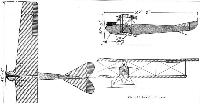 |
Журнал - Flight за 1914 г. |
| 25. The L.V.G. biplane. |
 |
J.Herris - LVG Aircraft of WWI. Volume 3: Types C.VI-C.XI & Fighters /Centennial Perspective/ (36) |
| LVG B.I Early |
 |
J.Herris - LVG Aircraft of WWI. Volume 3: Types C.VI-C.XI & Fighters /Centennial Perspective/ (36) |
| LVG B.I |
 |
J.Herris - LVG Aircraft of WWI. Volume 3: Types C.VI-C.XI & Fighters /Centennial Perspective/ (36) |
| LVG B.I |
 |
J.Herris - LVG Aircraft of WWI. Volume 3: Types C.VI-C.XI & Fighters /Centennial Perspective/ (36) |
| LVG B.I |